Gastrobronchial fistula after sleeve gastrectomy and gastric bypass: endoscopic management and prevention
- نوع فایل : کتاب
- زبان : انگلیسی
- مؤلف : Josemberg Marins Campos & Eduardo Franca Pereira & Luis Fernando Evangelista & Luciana Siqueira & Manoel Galvمo Neto & Victor Dib & Marcelo Falcمo &
- چاپ و سال / کشور: 2011
Description
Gastrobronchial fistula (GBF) is a serious complication following bariatric surgery, whose treatment by thoracotomy and/or laparotomy involves a high morbidity rate. We present the outcomes of endoscopic management for GBF as a helpful technique for its healing process. This is a multicenter retrospective study of 15 patients who underwent gastric bypass (n=10) and sleeve gastrectomy (n=5) and presented GBF postoperatively (mean of 6.7 months). Ten patients developed lung abscess and were treated by antibiotic therapy (n=10) and thoracotomy (n=3). Abdominal reoperation was performed in nine patients for abscess drainage (n=9) and/or ring removal (n=4) and/or nutritional access (n=6). The source of the GBF was at the angle of His (n=14). Furthermore, 14 patients presented a narrowing of the gastric pouch treated by 20 or 30 mm aggressive balloon dilation (n=11), stricturotomy or septoplasty (n=10) and/or stent (n=7). Fibrin glue was used in one patient. We performed, on average, 4.5 endoscopic sessions per patient. Endotherapy led to a 93.3% (14 out of 15) success rate in GBF closure with an average healing time of 4.4 months (range, 1–10 months), being shorter in the stent group (2.5×9.5 months). There was no recurrence during the average 27.3-month follow-up. A patient persisted with GBF, despite the fibrin glue application, and decided to discontinue it. GBF is a highly morbid complication, which usually arises late in the postoperative period. Endotherapy through different strategies is a highly effective therapeutic option and should be implemented early in order to shorten leakage healing time.
OBES SURG DOI 10.1007/s11695-011-0444-8


